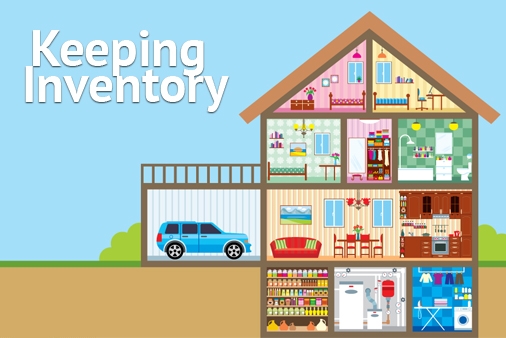Spring cleaning is the perfect time to create or update your household inventory.
Fire, flood, burglary and other disastrous occurrences can be stressful, but recovering from them can be even more challenging if you’re not prepared. Having an up-to-date list of your home’s contents will ease and expedite the process of replacing them if anything happens. It is also a good idea to photograph the outside of your home and your vehicles. According to the Insurance Information Institute, having a home inventory list will “help you replace lost items, help you verify losses for your income tax return, and help you purchase the correct amount of insurance.”

How to take household inventory
There are different ways to prepare your home inventory. You can hand-write everything down in a list. Or you can take pictures of the items and add them, with accompanying information, to your computer. If you have a video camera, you can walk through your house filming and describing the contents at the same time. You can use spreadsheets, or you can use home inventory software. Whichever method you choose, it’s important to be thorough. Be certain to check the contents of closets, storage spaces and other areas you may not access very often. If you have receipts or bill of sales for the items, include them in your photographs and/or record taking.
Also as you fill out your inventory, take special care when recording your electronic equipment and jewelry. These may be among your most valuable items and are often the target of theft. Wherever you can, list the serial numbers. If your valuables are ever recovered, you can prove ownership more easily if you can identify them by number.
Make a list. When creating the list, categorize by room. Walk through the room in a grid-like pattern so you do not overlook anything. Write down the description of the item, it’s color, monetary value, approximate age, model number, and any other information that helps identify it. Give it a unique identification number and then take a photo of the item. Label the photo with that same ID number for easy referencing. If you have receipts, include them in the photo to help save time and keep the task manageable. You might even want to do a walk-through video. Now-a-days, most digital cameras have video capture ability, so you could record a quick video clip of each room in your home, and store the video clips and digital photos on a flash drive with your inventory.
Spreadsheets. If you are familiar with spreadsheet software such as Microsoft Excel or OpenOffice, this is one of the best ways to keep household inventory. You can easily update the information, and a copy of the file can be stored “off-site” so you don’t risk losing the data if something happens to your home. Google Drive even allows you to keep spreadsheets online, storing your valuable data on a secure remote server. However you decide to create and keep your inventory spreadsheet, make sure you keep a saved copy somewhere off-premise so it stays safe if something were to happen to your home.
Download this sample spreadsheet for a quick start to creating your own household inventory.
Home inventory software. The Insurance Information Institute provides a free app that allows you to record and update a list of your home’s contents from your iPhone, Android or home computer. The information is stored on a password protected account on secure servers. This means no matter what happens in your home, your information is safe and you can access it from anywhere.
Home inventory software is a popular choice for today’s home-owner, and a quick Google search will result in countless versions available for purchase. Be sure to do some research on the various options before deciding on one.
You should update your list annually or anytime you acquire or discard items of value. You may find that the value of your property is much greater than you thought. If so, contact your Farm Bureau Insurance agent to make sure you have adequate coverage.